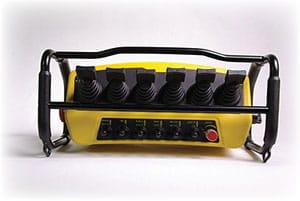Hyundai R220LC Hi-POSS Excavator | New Technology, New Benefits for You
If you missed ConExpo back in March, you missed seeing Hyundai’s latest excavator prototype, the R220LC Hi-POSS. Hi-POSS stands for Hyundai Intelligent Power Optimal Sharing and Energy Saving. It’s definitely a new generation of excavator – exciting, but not yet available on the market.
Field tests are currently underway in Korea, however, and Hyundai reports the new technology can reduce fuel consumption by 20% or more. But it’s the R220LC’s more precise, effective handling that’s drawing the most attention.
It’s a two-part system.
An accumulator system uses two large, nitrogen-filled accumulators mounted underneath the frame to capture regenerative braking energy from boom down, cab swing stop and bucket out functions. The accumulators then release the captured energy back into the system, where it’s recycled. This reduces overall energy consumption.
Electronically controlled poppet valves – 20 in series – regulate hydraulic flow and pressure. Normally, excavators use separate spool valves for each function. With the series of poppet valves, each function can be controlled by multiple valves.
The overall result is a next-level excavator that’s easier to operate, with more efficient main relief flow, swing start, swing stop and boom down. Hyundai says this all adds up to a decrease in fuel consumption that could be as much as 20%.
The more precise electronically controlled valves allow independent flow control, and the machine can be tuned to fit individual operators and job applications without having to add components. The Hi-POSS computerized system adjusts speed ratio between attachments and matches joystick signal and single operation speed. With the proper software, operating computers can be clustered.
Poppets are the secret to the R220LC Hi-POSS system success.
According to Hyundai’s Todd Johnson, poppet valves can deliver far more precise amounts of hydraulic pressure and flow. Each valve just opens and closes, but they vary in their amount of pressure and flow. Johnson is CE director for Hyundai Construction Equipment Americas. “When a guy wants to feather the controls, one valve will open,” he explains. If the operator wants a little more, two valves will open, and for the heaviest applications a computer controls the sequence of valves opening, possibly all 20.
Johnson says that eliminates any need for relief, because the machine doesn’t generate extra oil that would normally go into a relief valve, then back into the tank. The newly-designed system is simply more efficient. It uses less fuel, it’s quieter, it’s cooler and hydraulic fluid lasts longer.
Switching to poppet valves also improves working with attachments and the machine’s auxiliary system. Normally, it’s easy to adjust flow on an excavator, but the operator may have to manually set relief valves in order to change pressure settings.
Remote control?
 Hyundai is investigating the possibility of operating the R220LC Hi-POSS excavator remotely. They cite two advantages to remote control. First, operators wouldn’t need such a high level of expertise to feather the bucket for precise work – the electronically-controlled poppet valve system could actually replicate that skill and feel.
Hyundai is investigating the possibility of operating the R220LC Hi-POSS excavator remotely. They cite two advantages to remote control. First, operators wouldn’t need such a high level of expertise to feather the bucket for precise work – the electronically-controlled poppet valve system could actually replicate that skill and feel.
Second, Hyundai’s long-term vision is a quarry or mine site where the excavator’s operator is housed in a remote building, running the machine from a computer screen. More productive, much safer.
Hyundai Heavy Industries, the parent company of Hyundai Construction Equipment, has a long history of investing in construction equipment research and development. The R220LC Hi-POSS is their latest contribution to the industry. The prototype model currently being tested in Korea is a 20-ton machine, with a 143 hp Cummins Tier 3 QSB6.7 engine. It has an operating weight of 50,520 lbs, a maximum dig depth of just over 22 feet and 31,830 lbs of bucket breakout force.
Hyundai projects that production models, when they become available, will probably be 30- or 40-ton excavators.
